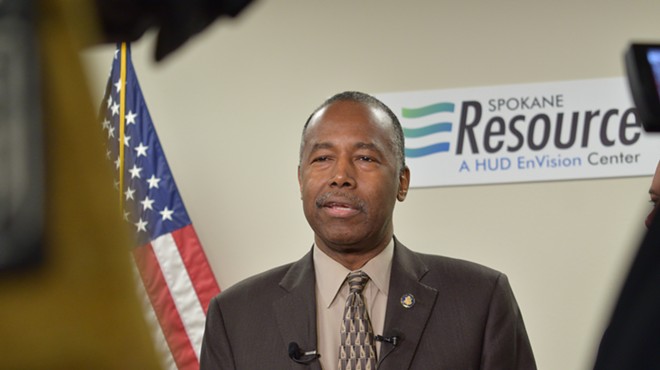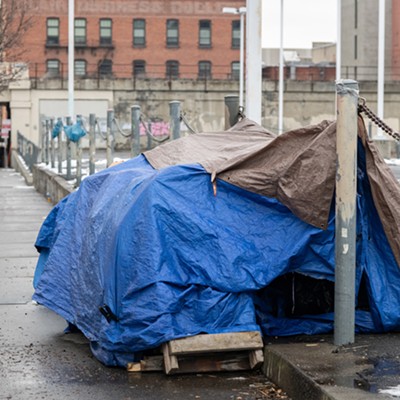"Ben has said that I don't talk about stats. I'll give you a stat. How about the National Coalition for the Homeless?" Woodward said. "The National Coalition for the Homeless says that 36 percent of the homeless have an alcohol addiction, 26 percent have a drug addiction. Twenty to 25 percent are mentally ill. You add that together? That's 80 to 85 percent of what we're seeing on the street."
The crowd erupted into a chorus of laughter and scoffing, but Woodward stuck to her guns.
"Look up the numbers!" Woodward insisted. "It's absolutely true."
The likely source of the crowd's derision? You can't add those numbers together like that.
Say you had a classroom where 60 percent of the students were fluent in French and 60 percent of students were fluent in Spanish. You couldn't just add those stats together to say that 120 percent of the students were fluent in a foreign language. Some students are clearly in fluent in both languages.
Similarly, being addicted to drugs, being addicted to alcohol and having a mental illness are not mutually exclusive categories. In fact, it's so common for people with substance abuse issues to also have mental illness that there are terms for it like "dual diagnosis" and "co-occurring disorders."
But in the meantime, the Inlander spoke with the National Coalition for the Homeless' acting director, John Parvensky, and he says he doesn't recognize the exact figures Woodward used.
In recent years, he says, the National Coalition for the Homeless has given up trying to publish precise figures to the number of homeless people with addiction or mental illness. Part of it's because of the immense challenges with calculating a statistic like that. And part of it is how "people are using that data to either stigmatize the homeless population or coming up with more treatment interventions as opposed to housing."
The closest the Inlander could find to the figures Woodward cited were from two decade-old fact sheets from the National Coalition for the Homeless. Both of these pages direct back to a 2003 webpage from the Substance Abuse and Mental Health Services Administration. The data is based on a 1999 Urban Institute paper crunching data from a 1996 National Survey of Homeless Assistance Providers and Clients survey. The survey is 23 years old, being conducted the same year that Michael Jordan and Bugs Bunny were taking theaters by storm with the major motion picture Space Jam.
We shared the fact-sheets with Parvensky, and he was unequivocal: You can't add those numbers together.
"It would not be appropriate to add the mental illness, alcohol abuse and drug abuse percentages together to come up with the total percentage with these issues, as many people have co-occurring disabilities," he writes. "Among the homeless population, those with mental illness are likely to self-medicate with drugs or alcohol, and those with substance use disorders generally have an underlying mental health condition."
In fact, the 1996 survey of providers did track how many respondents had a substance abuse or any kind of mental health issue. But when calculated correctly, it was only two-thirds — not 80-85 percent of homeless people.
Anything more recent?
"There are no authoritative numbers regarding the number of people experiencing homelessness with mental illness, substance abuse disorders or co-occurring conditions," Parvensky says.
He notes that the recent Council of Economic Advisors reported that 20 percent of homeless people in a 2018 point-in-time homeless count self-reported a "severe mental illness" and 16 percent said they suffered from chronic substance abuse. Similarly, the Annual Homeless Assessment Report looked at a 2019 point-in-time counts and indicated that 17.5 percent of people were "chronically homeless," which typically includes a mental illness, addiction or physical disability. In recent years, he says, the chronically homeless population in Washington state has spiked up significantly.
But all these reports come with an asterisk: Because the methods used in the point-in-time counts can vary wildly from city to city, the data can be spotty.
Not only that, Parvensky says, but it's hard to determine cause and effect, he says. Are you homeless because you drink? Or do you drink because you're homeless?
All of this, of course, goes back to the underlying debate during this election: Are increases in homelessness related to drug addiction or to problems with housing?
Housing costs. Parvensky says. The problem is housing.
"We're seeing the greatest increase in homelessness in the communities that have the greatest increases in housing costs," Parvensky says.
It's not that addiction or mental illness doesn't play a factor. But most people who are addicted or mentally ill live in houses. When costs are low and plenty of housing is available, many people with substance abuse issues and mental illnesses are still able to make rent. But when the vacancy rate is low or rents or high, there's so much competition for housing that the people with behavioral health issues can end up out on the streets.
"The shortage of housing and the shortage of quality of shelters tends to be driving the in-street homelessness and homelessness overall," Parvensky says."The shortage of housing and the shortage of quality of shelters tends to be driving the in-street homelessness and homelessness overall."
tweet this
But how about the concern that, by offering better services, you end up attracting a lot more homeless people to the area? Parvensky doesn't buy it.
"I've been doing this work for 35 years," Parvensky says. "Every community I talked to said they were the magnet, that they were attracting to homeless people to the community. And that's impossible to be the case."
Instead, he says, the vast majority of people experiencing homelessness have existing ties to the community they're homeless in. Sure, there's mobility from town to town. But generally homeless people move from town to town for the same reason everyone else does. They move for a job or a job opportunity. They move to someplace where the climate is better. They move because their family is there.
Does getting tougher on the homeless encourage people to leave the lifestyle? Nope, Parvensky says.
"There is no body of evidence that shows that criminalization or cracking down on people who are using drugs or alcohol is going to reduce homelessness and move people into housing," he says.
We also asked Parvensky about critiques with the Housing First model, which seeks to put the homeless individuals who've been on the street the longest directly into housing, setting them up to get better services. He says the overall strategy is great, but it can run into two problems. First, it can create this weird situation where people don't get housing because they haven't been homeless long enough.
The other critique he has he actually shares with Woodward: Many times, Housing First units don't have enough drug or mental health treatment services connected to them.
In other words, there are problems with the Housing First model, he says, but that's usually because it doesn't get enough funding.
The solution isn't to abandon Housing First, he says. The solution is to offer a lot more of it.





























